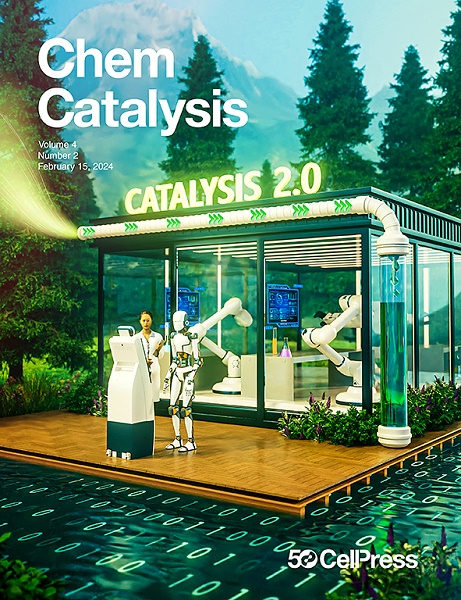空间无偏置芳香酮的π-π相互作用定向不对称氢化反应
IF 11.6
Q1 CHEMISTRY, PHYSICAL
引用次数: 0
摘要
过渡金属催化的酮类不对称加氢反应已经得到了很好的证实;然而,立体无偏置酮的不对称加氢仍然是一个主要的挑战,主要是由于难以控制对映体选择性。在这里,我们报告了一种高度实用和高效的方案,用于这些底物的不对称氢化,以高达99%的收率和99%的对映体过量(ee)交付手性环二芳醇(包括巴洛韦中间体)。机理研究表明,[Ir(cod)Cl]2与氧-螺环配体发生分子内C-H氧化活化,形成刚性的蝴蝶形Ir - pnnc配合物,单晶x射线衍射证实了这一点。在我们的理解中,这种四齿结合既可以防止催化剂被含硫底物中毒,又可以最大限度地提高对映选择性,借助于关键的π-π相互作用(如密度泛函理论[DFT]和非共价键相互作用[NCI]分析所揭示的)。具有良好立体控制的克级加氢证明了合成的实用性,强调了这种方法有效制备有价值的对映纯化合物的潜力。本文章由计算机程序翻译,如有差异,请以英文原文为准。

π-π interaction-directed asymmetric hydrogenation of sterically unbiased aromatic ketones
Transition metal-catalyzed asymmetric hydrogenation of ketones has been well established; however, the asymmetric hydrogenation of sterically unbiased ketones remains a major challenge, primarily due to difficulties in controlling enantioselectivity. Here, we report a highly practical and efficient protocol for the asymmetric hydrogenation of such substrates, delivering chiral cyclic diaryl alcohols (including the baloxavir intermediate) in up to a 99% yield and 99% enantiomer excess (ee). Mechanistic studies show that [Ir(cod)Cl]2 undergoes intramolecular oxidative C–H activation with an oxa-spirocyclic ligand, forming a rigid, butterfly-shaped Ir–PNNC complex, as confirmed by single-crystal X-ray diffraction. In our understanding, this tetradentate binding both prevents catalyst poisoning by sulfur-containing substrates and maximizes enantioselectivity, aided by crucial π-π interactions (as revealed by density functional theory [DFT] and non-covalent bond interaction [NCI] analyses). The synthetic practicality is demonstrated by gram-scale hydrogenation with excellent stereocontrol, underscoring the potential of this approach for the efficient preparation of valuable enantiopure compounds.
求助全文
通过发布文献求助,成功后即可免费获取论文全文。
去求助
来源期刊
CiteScore
10.50
自引率
6.40%
发文量
0
期刊介绍:
Chem Catalysis is a monthly journal that publishes innovative research on fundamental and applied catalysis, providing a platform for researchers across chemistry, chemical engineering, and related fields. It serves as a premier resource for scientists and engineers in academia and industry, covering heterogeneous, homogeneous, and biocatalysis. Emphasizing transformative methods and technologies, the journal aims to advance understanding, introduce novel catalysts, and connect fundamental insights to real-world applications for societal benefit.

 求助内容:
求助内容: 应助结果提醒方式:
应助结果提醒方式:


